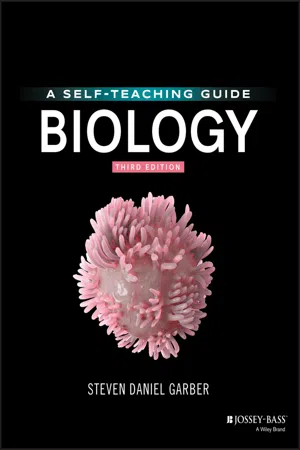Biological Sciences
Seedless Vascular Plants
Seedless vascular plants are a group of plants that have specialized vascular tissues for the transport of water, minerals, and nutrients. They reproduce through spores rather than seeds, and include ferns, horsetails, and clubmosses. These plants have a distinct life cycle with alternating generations of sporophyte and gametophyte stages.
Written by Perlego with AI-assistance
Related key terms
1 Key excerpts on "Seedless Vascular Plants"
- eBook - ePub
Biology
A Self-Teaching Guide
- Steven D. Garber(Author)
- 2020(Publication Date)
- Jossey-Bass(Publisher)
leaves” because of a lack of better terminology.Moss, illustrating rhizoids, leafy gametophytes, and attached sporophytes. The same plant has sporophyte and gametophyte generation (sporophyte grows from the gametophyte).Figure 20.1VASCULAR PLANTS
Some of the earliest known vascular plants had roots that functioned as holdfasts and absorbed water. They also had vascular tissue for water and nutrient movement. This tissue also provided strength and helped hold the plant up in the air. In addition, these early vascular plants had a waxy cuticular layer covering the leaves for water retention. The fossil record indicates there was a trend toward the reduction of the gametophyte generation in favor of the more dominant sporophyte generation, which contained the sporangia. The earliest vascular plants probably produced only one kind of spore from one kind of sporangium, a process called homospory. After germination, these spores developed into gametophytes with antheridia and archegonia. They produced the sperm and eggs, respectively. However, the trend toward heterospory (the production of two different kinds of spores) is also evident in the overall evolution of the vascular plants.Following the evolution of the aquatic vertebrates, which took place about 500 million years ago, the first vascular plants to colonize the land appear in the fossil record; at about the same time, some arthropods also began colonizing terrestrial habitats.A significant innovation unique to the vascular plants is the seed, which consists of an embryo and some stored food enclosed within a protective coat. The earliest known fossilized seeds date back 350 million years.Five major groups of tracheophytes, or vascular plants, are discussed below. To date, more than 260,000 species of vascular plants have been described.
Learn about this page
Index pages curate the most relevant extracts from our library of academic textbooks. They’ve been created using an in-house natural language model (NLM), each adding context and meaning to key research topics.
